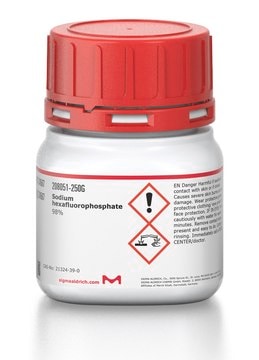931950
Sodium perchlorate
anhydrous, ≥99.9% trace metals basis
Synonim(y):
Sodium Perchlorate, Hyperchloric acid sodium salt
About This Item
Polecane produkty
klasa czystości
anhydrous
battery grade
Poziom jakości
Próba
≥99.9% trace metals basis
Postać
powder
zanieczyszczenia
≤1000 ppm (trace metals analysis)
pH
6.0-8.0 (25 °C, 5%, aq.sol.)
mp
482 °C
rozpuszczalność
H2O: 209 g/dL at 15 °C
ślady anionów
chloride (Cl-): ≤30 ppm
sulfate (SO42-): ≤20 ppm
ślady kationów
Fe: ≤5 ppm
K: ≤500 ppm
Zastosowanie
battery manufacturing
InChI
1S/ClHO4.Na/c2-1(3,4)5;/h(H,2,3,4,5);/q;+1/p-1
Klucz InChI
BAZAXWOYCMUHIX-UHFFFAOYSA-M
Szukasz podobnych produktów? Odwiedź Przewodnik dotyczący porównywania produktów
Powiązane kategorie
Opis ogólny
Zastosowanie
Opakowanie
25 g in glass bottle
Hasło ostrzegawcze
Danger
Zwroty wskazujące rodzaj zagrożenia
Zwroty wskazujące środki ostrożności
Klasyfikacja zagrożeń
Acute Tox. 4 Oral - Eye Irrit. 2 - Ox. Sol. 1 - STOT RE 2
Organy docelowe
Thyroid
Kod klasy składowania
5.1A - Strongly oxidizing hazardous materials
Klasa zagrożenia wodnego (WGK)
WGK 1
Certyfikaty analizy (CoA)
Poszukaj Certyfikaty analizy (CoA), wpisując numer partii/serii produktów. Numery serii i partii można znaleźć na etykiecie produktu po słowach „seria” lub „partia”.
Masz już ten produkt?
Dokumenty związane z niedawno zakupionymi produktami zostały zamieszczone w Bibliotece dokumentów.
Nasz zespół naukowców ma doświadczenie we wszystkich obszarach badań, w tym w naukach przyrodniczych, materiałoznawstwie, syntezie chemicznej, chromatografii, analityce i wielu innych dziedzinach.
Skontaktuj się z zespołem ds. pomocy technicznej









